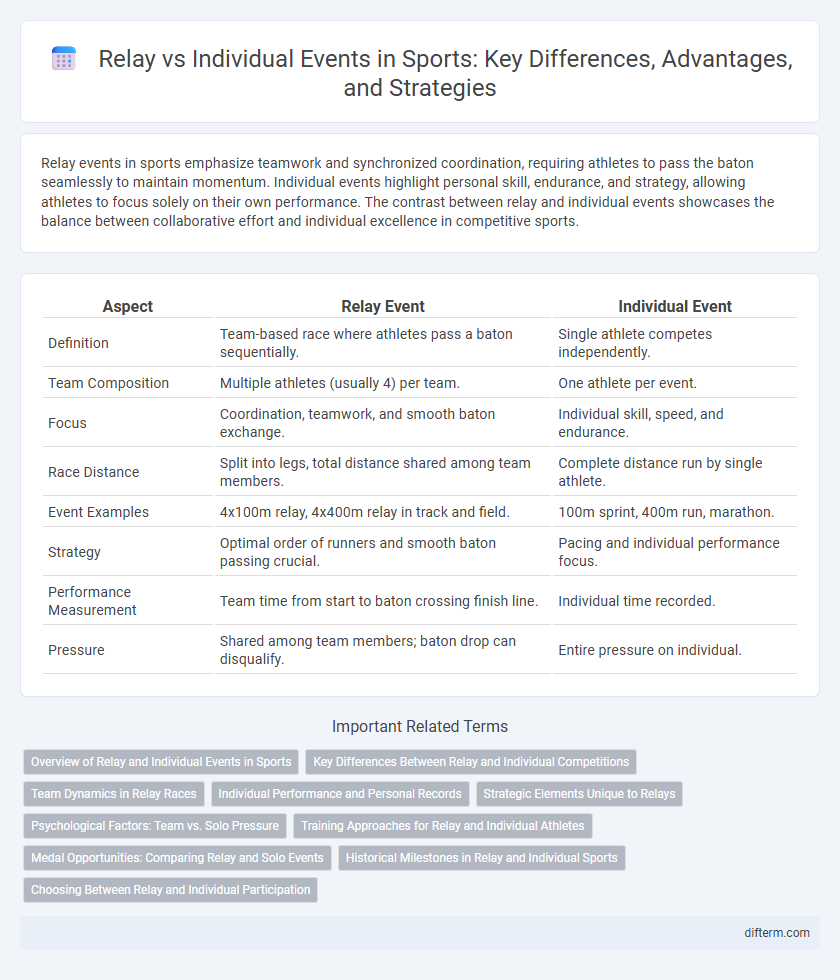Relay events in sports emphasize teamwork and synchronized coordination, requiring athletes to pass the baton seamlessly to maintain momentum. Individual events highlight personal skill, endurance, and strategy, allowing athletes to focus solely on their own performance. The contrast between relay and individual events showcases the balance between collaborative effort and individual excellence in competitive sports.
Table of Comparison
| Aspect | Relay Event | Individual Event |
|---|---|---|
| Definition | Team-based race where athletes pass a baton sequentially. | Single athlete competes independently. |
| Team Composition | Multiple athletes (usually 4) per team. | One athlete per event. |
| Focus | Coordination, teamwork, and smooth baton exchange. | Individual skill, speed, and endurance. |
| Race Distance | Split into legs, total distance shared among team members. | Complete distance run by single athlete. |
| Event Examples | 4x100m relay, 4x400m relay in track and field. | 100m sprint, 400m run, marathon. |
| Strategy | Optimal order of runners and smooth baton passing crucial. | Pacing and individual performance focus. |
| Performance Measurement | Team time from start to baton crossing finish line. | Individual time recorded. |
| Pressure | Shared among team members; baton drop can disqualify. | Entire pressure on individual. |
Overview of Relay and Individual Events in Sports
Relay events in sports emphasize team coordination and baton exchanges, requiring seamless collaboration among athletes to achieve peak performance. Individual events focus on singular athlete endurance, skill, and speed, highlighting personal achievement without reliance on teammates. Both event types demand specialized training and strategic execution tailored to their distinct competitive dynamics.
Key Differences Between Relay and Individual Competitions
Relay competitions involve teams of multiple athletes who each complete a segment of the race, emphasizing teamwork and precise baton exchanges, whereas individual events focus solely on a single athlete's performance and endurance. Relay races require strategic coordination and synchronization to optimize overall time, while individual competitions highlight personal skill, speed, and stamina without direct reliance on teammates. Key differences include the presence of team dynamics in relays and the solitary challenge of individual events, shaping distinct training approaches and psychological demands.
Team Dynamics in Relay Races
Relay races highlight the critical importance of seamless team dynamics, where precise baton exchanges and coordinated pacing significantly impact overall performance. Unlike individual events that rely solely on personal speed and endurance, relays demand strategic collaboration, timing, and trust among teammates to maximize combined strengths. Effective communication and synchronization during handoffs can reduce time losses and create a competitive edge in high-stakes competitions.
Individual Performance and Personal Records
Individual events in sports emphasize personal performance and the pursuit of personal records, allowing athletes to showcase their unique abilities without relying on teammates. Success in these events often depends on an athlete's speed, technique, and endurance, directly reflecting their training and skill level. Tracking personal records in individual competitions provides a clear metric for progress and motivates continuous improvement.
Strategic Elements Unique to Relays
Relay events in sports demand precise coordination and seamless baton exchanges to optimize overall team performance, contrasting with the singular focus on individual skill in solo competitions. Strategic positioning of runners based on their strengths, such as placing the fastest athlete as the anchor, maximizes the team's competitive advantage. Synchronization, adaptability during exchanges, and managing cumulative fatigue are critical elements that distinguish relay races from individual events.
Psychological Factors: Team vs. Solo Pressure
Relay events generate a unique psychological environment where athletes experience shared pressure and collective responsibility, often boosting motivation and resilience. Individual events place the entire psychological burden on one competitor, intensifying stress and the need for self-reliance. The contrast between team support in relays and solo accountability shapes distinct mental strategies and performance outcomes for athletes.
Training Approaches for Relay and Individual Athletes
Training approaches for relay athletes emphasize seamless baton exchanges, synchronization, and team coordination to optimize overall performance. Individual event training focuses on personalized techniques, pacing strategies, and mental resilience tailored to the athlete's specific discipline. Both methods require targeted conditioning but differ significantly in skill emphasis and teamwork dynamics.
Medal Opportunities: Comparing Relay and Solo Events
Relay events provide athletes multiple medal opportunities through team collaboration, increasing the chances of podium finishes across different relay formats like 4x100m or 4x400m. Individual events offer a direct path to medals based solely on personal performance, allowing athletes to showcase their specific strengths in sprinting, long-distance running, or field events. The strategic dynamics of relay races can enhance medal prospects, while solo events emphasize individual excellence and specialization in sports competitions.
Historical Milestones in Relay and Individual Sports
The 4x100 meter relay was first introduced at the 1912 Stockholm Olympics, revolutionizing track and field by emphasizing team coordination alongside speed. Jesse Owens' individual 100 meters victory at the 1936 Berlin Olympics became an iconic milestone, showcasing personal athletic excellence under intense global scrutiny. The evolution of relay batons and changeover techniques has continuously improved world record times, while individual events remain a testament to singular talent and dedication.
Choosing Between Relay and Individual Participation
Choosing between relay and individual participation depends on an athlete's strengths, team dynamics, and event strategy; relay events emphasize coordination, baton exchanges, and collective speed while individual events highlight personal skill, endurance, and mental focus. Athletes excelling in sprinting and seamless teamwork often prefer relays for potential medal opportunities and the synergy of group performance. Conversely, those confident in pacing, technique, and solo competition skills may prioritize individual events to maximize personal achievements and record times.
relay vs individual event Infographic

 difterm.com
difterm.com